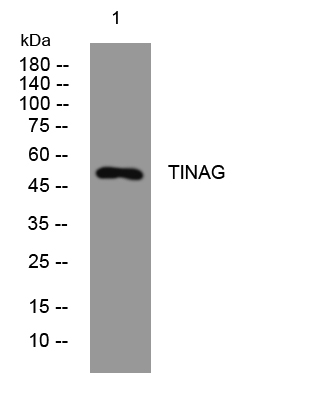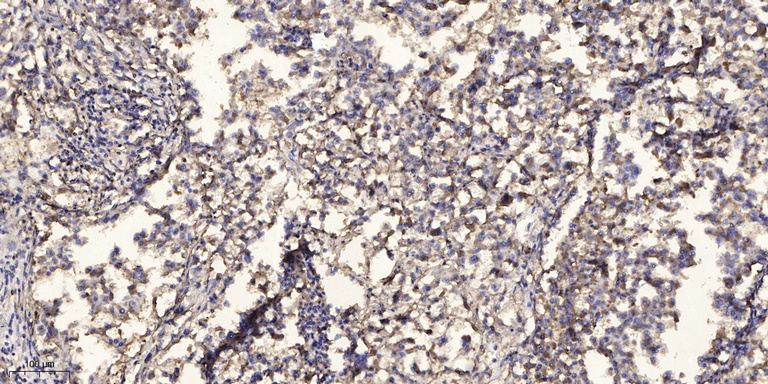- Home
- About
- Promotions
-
Products
-
Elisa Kits
- |
-
Primary antibodies
- |
-
Secondary antibodies
- |
-
Proteins
- |
-
IHC reagents
- |
-
WB reagents
- PonceauS Staining Solution
- PBST Washing Buffer, 10X
- 1.5M Tris-HCl Buffer, pH8.8
- 1M Tris-HCl Buffer, pH6.8
- 10% SDS Solution
- Prestained Protein Marker
- TBST Washing Buffer, 10X
- SDS PAGE Loading Buffer, 5X
- Stripping Buffered Solution
- Tris Buffer, pH7.4, 10X
- Total Protein Extraction Kit
- Running Buffer, 10X
- Transfer Buffer, 10X
- 30% Acr-Bis(29:1) Solution
- Tris电泳液速溶颗粒
- PBS(1X, premixed powder)
- TBS(1X, premixed powder)
- 快速封闭液
- 转膜液速溶颗粒
- Chemical reagents
- News
- Distributor
- Resources
- Contact
- Home
- >
- Info
- >
- TINAG rabbit pAb
- >
- Go Back
TINAG rabbit pAb
- Catalog No.:YT7714
- Applications:WB;IHC
- Reactivity:Human
- Immunogen:
- Synthesized peptide derived from human TINAG AA range: 80-130
- Specificity:
- This antibody detects endogenous levels of TINAG at Human
- Formulation:
- Liquid in PBS containing 50% glycerol, 0.5% BSA and 0.02% sodium azide.
- Source:
- Polyclonal, Rabbit,IgG
- Dilution:
- WB 1:500-2000;IHC 1:50-300
- Purification:
- The antibody was affinity-purified from rabbit antiserum by affinity-chromatography using epitope-specific immunogen.
- Storage Stability:
- -15°C to -25°C/1 year(Do not lower than -25°C)
- Molecular Weight(Da):
- 52kD
- Background:
- This gene encodes a glycoprotein that is restricted within the kidney to the basement membranes underlying the epithelium of Bowman's capsule and proximal and distal tubules. Autoantibodies against this protein are found in sera of patients with tubulointerstital nephritis, membranous nephropathy and anti-glomerular basement membrane nephritis. Ontogeny studies suggest that the expression of this antigen is developmentally regulated in a precise spatial and temporal pattern throughout nephrogenesis. [provided by RefSeq, Nov 2011],
- Function:
- developmental stage:Initially observed in the Bowman capsule during early glomerular capillary loop formation in the kidney. In more developmentally mature glomeruli, following transition from early to mid-capillary loop stage, expression is higher in the proximal tubular basement membrane than in the distal basement membrane and Bowman capsule.,disease:Antibodies against TINAG are found in sera of patients with tubulointerstitial nephritis, a rare autoimmune disorder that causes acute and chronic renal injury.,function:Mediates adhesion of proximal tubule epithelial cells via integrins alpha3-beta1 and alphaV-beta3.,PTM:It has been suggested that the active SMB domain may be permitted considerable disulfide bond heterogeneity or variability, thus 2 alternate disulfide patterns based on 3D structures are described with 1 disulfide bond conserved in both.,similarity:Belongs to the peptida
- Subcellular Location:
- Secreted, extracellular space, extracellular matrix, basement membrane .
- Expression:
- Expressed in the kidney cortex, small intestine and cornea.

- Western blot analysis of lysates from K562 cells, primary antibody was diluted at 1:1000, 4°over night

- Immunohistochemical analysis of paraffin-embedded human Squamous cell carcinoma of lung. 1, Antibody was diluted at 1:200(4° overnight). 2, Tris-EDTA,pH9.0 was used for antigen retrieval. 3,Secondary antibody was diluted at 1:200(room temperature, 45min).





